The Making of a “Massacre” Simcoe’s Surprise Attack at Hancock’s Bridge
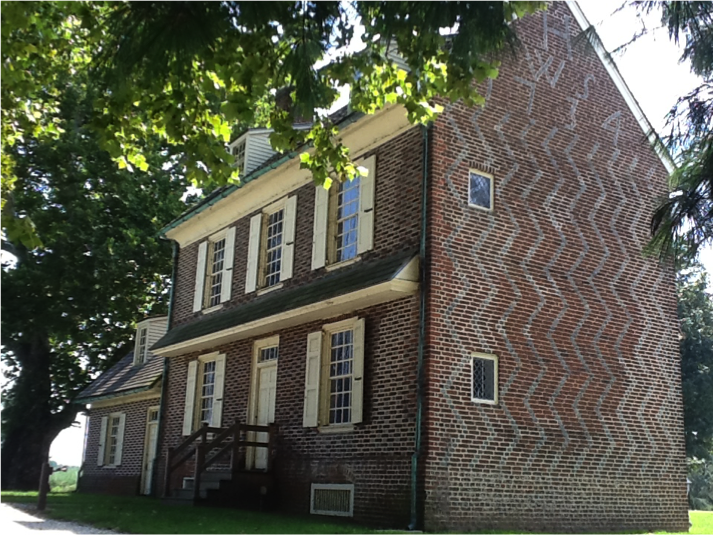
While the British army was quartered in Philadelphia for the winter of 1777-78 foraging parties were frequently sent out to gather supplies. One such expedition was sent to Salem County, New Jersey in March of 1778. British engineer, Captain John Montressor, recorded in his journal on March 11th:
“The Roebuck removed from the wharves into the stream and the Camilla fell down the river and in the afternoon followed her a detachment of 1,000 men under the command of Col. Mawhood, 17th, 27th, and 46th Regiments, Simcoe’s Rangers.” [1]
Upon arrival to Salem on the 17th of March, Mawhood had all intentions of keeping peace with the local population and to pay for all provisions taken. Major Simcoe writes: “Colonel Mawhood had given the strictest charge against plundering…” [2] but before the expedition was over, the Queen’s Rangers would spark outrage and distain by their treatment of the local rebel militia at Quinton’s Bridge, on the 18th and at Hancock’s Bridge on the 21st. The later would be called a “massacre”.
When the British arrived and took control of the town of Salem, the local militias formed to try and impede Mawhood’s movements. The Alloway, a tidal creek of the Delaware River south of Salem, was chosen as a natural defensive line by the militia to stop the British from moving towards Bridgeton. There were three crossings over the creek: Hancock’s Bridge (closest to the Delaware), Quinton’s Bridge (in the middle) and Thompson’s bridge (furthest east), and each would be guarded.
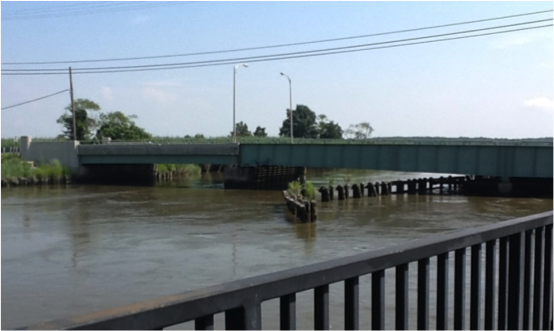
The first skirmish between Mawhood’s force and the militia occurred on the 18th of March and involved a foraging party of the 17th Regiment of Foot and the Queen’s Rangers. The rebels were bloodied and many were killed or captured, but the defenses held because of timely reinforcements from Bridgeton. Frustrated by the resistance of the locals, Mawhood determined to attack Hancock’s Bridge and gave the task to Major Simcoe and his Rangers, with support from the 27th Regiment of Foot. Simcoe gives his account of the action:
“Colonel Mawhood determined to attack them at [Hancock’s Bridge], where, from all reports, they were assembled to near four hundred men… [The Queen’s Rangers] embarked on the 20th, at night, on board flat bottom boats… everything depended upon surprise. The enemy were nearly double his numbers... [The Rangers] land[ed] in the marshes, at the mouth the Aloes creek… after a march of two miles through marshes… they at length arrived… upon dry land. Here the corps was formed to attack… On approaching the place [Hancock’s Bridge], two sentries were discovered: two men of the light infantry followed them, and as they turned about, bayoneted them…the light infantry… reached Hancock’s house by the road and forced the front door, at the same time that Captain Dunlop… entered the back door; as it was very dark, these companies nearly attacked each other… The surprise was complete, and would have been so, had the whole of the enemy’s force been present, but, fortunately for them, they had quitted it the evening before, leaving a detachment of twenty or thirty men, all of whom were killed… Some very unfortunate circumstances happened here. Among the killed was a friend of the government… old Hancock, the owner of the house… events like these are the real miseries of war.” [3]
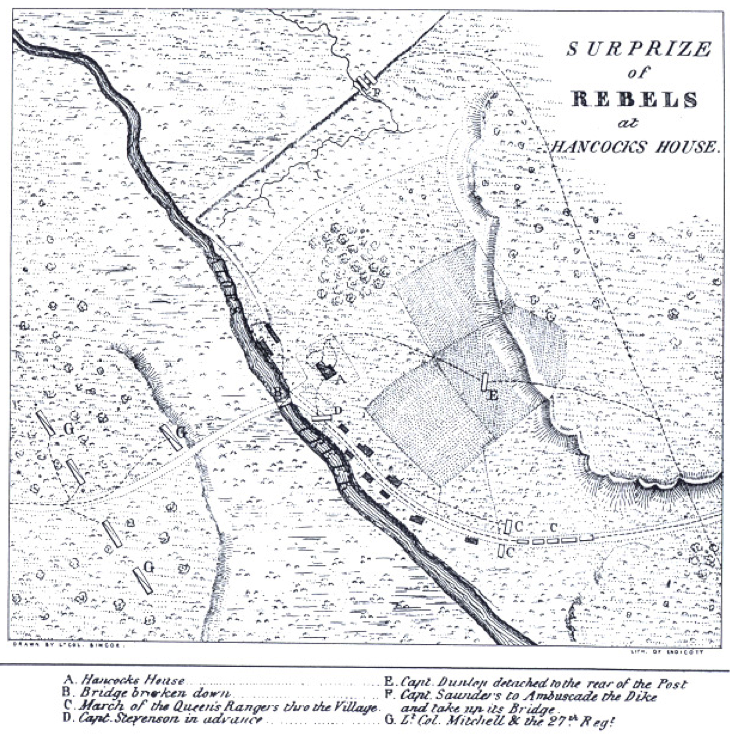 Though with somewhat inflated militia numbers, another defense of the Ranger’s actions comes from author James Hannay’s book History of the Queen’s Rangers:
Though with somewhat inflated militia numbers, another defense of the Ranger’s actions comes from author James Hannay’s book History of the Queen’s Rangers:
“Capt. Dunlop's and Stephenson's companies attacked those in the house with such fury that every man in it was killed. This was a lamentable occurrence and has enabled American writers to assert that these men were massacred, but it must be remembered that it was a night attack and that Simcoe's Rangers, instead of this insignificant detachment, expected to meet a force of at least 700 or 800 men, and, of course, a desperate resistance was expected.” [4]
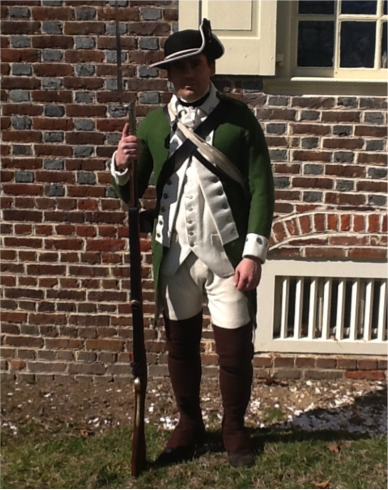
There is still a cloud of confusion surrounding the number of militia actually present that night and how many men, including civilians, were killed. Simcoe states that “all were killed”, but other accounts maintain that there were prisoners taken. British Military Engineer, Archibald Robertson was on the expedition to Salem and recorded in his journal:
“This night [20th of March] Simcoe’s Rangers embarked in the flat boats and went round to the south side of Alloes Creek to surprise the Rebel post at Hancock’s Bridge. The Rangers got behind the Rebels. Killed 16 and took 11 prisoners.” [5]
Lt. Reuel Sayre, one of the militia members attacked at Hancock’s Bridge, recalled later:
“…they came upon us by surprise… All were killed, left for dead or taken prisoners but myself… I had one brother killed and one taken prisoner in this night affair.” [6]
The main purpose of the attack was to gain the south side of the bridge, not to put all to death and quarter was given to some. Simcoe was surprised at the lack of resistance and did not know the Rangers were attacking so few. He expected only the officers to be quartered in the Hancock House, not the entire guard. Captain Carlton Sheppard’s company militia was the only one stationed at the bridge, and was quickly overpowered. When the attack was finished, Simcoe laid the planks down over the bridge in order to confer with Lt. Col. Mitchell of the 27th Regiment, waiting on the other side of the creek, as what to do next:
“Major Simcoe communicated to Colonel Mitchell, that the enemy were at Quinton’s Bridge; that he had good guides to conduct them thither by a private road, that the possession of Hancock’s house secured a retreat. Lieutenant-Colonel Mitchell said, that his regiment was much fatigued by the cold, and that he would return to Salem as soon as the troops joined. The ambuscades were of course withdrawn, and the Queen’s Rangers were forming to pass the bridge, when a rebel patrol passed where an ambuscade had been, and discovering the corps, galloped back. Lieutenant-Colonel Mitchell… being informed of the enemy’s patrol, it was thought best to return [to Salem].” [7]
Though the Queen’s Rangers were successful, they again gave up the south side of the Alloway Creek. The outcome of the attack had a demoralizing effect on the militia. When word spread of the affair at Hancock’s Bridge, the resolve to continue a defense at the Alloway dissolved. Colonels Hand and Holme of the militia wrote Governor Livingston:
“We have made our stand on Alloways Creek… but last night the enemy landed out of their boats… and surrounded our guard at Hancock’s Bridge and took and killed almost all of them… we fear they will advance over all these lower counties… we find our numbers at present are not large enough to make a proper stand against them…” [8]
The militia moved south nearly 18 miles to Cumberland County and made the Cohansey River their new defensive line, leaving all of Salem County open to British foraging. After 6 more days of collecting supplies, the British embarked on their ships on the 27th of March and headed back to Philadelphia. The scars left on the inhabitants of Salem County were not easily forgotten. The Hancock House “Massacre” became a rallying cry and may have helped bolster Washington’s ranks in the spring of 1778:
“The nightmare of sanguinary warfare cause by the affairs at Quinton and Hancock’s Bridge produced one effect… the ire of the local militia had been excited because the raiders had escaped practically free of any kind of punishment. As matters of patriotism and retaliation the militia began to enlist in increasing numbers in the State and Continental Army troops.” [10]
One story passed down through history demonstrates the lasting resentment that formed due to Simcoe’s attack at Hancock’s Bridge and the “massacre” that occurred there:
“Later Judge Hancock’s son and a Mr. Sayer, whose father had been killed in the massacre, traveled to Philadelphia by water. They were standing on the wharf talking with two strange men when Sayer fell overboard. One of the strangers jumped in and rescued him. Mr. Sayer asked, ‘To whom am I indebted for saving my life?’ When the man told him he was the son of Colonel Mawhood, Sayer said, ‘I’ll be damned if I’ll be saved by the son of the murderer of my father!’ and jumped in the river again. He was rescued with difficulty.” [11]
It seems that Colonel Mawhood and Major Simcoe will forever be associated with the Hancock House “massacre”, deserved or not.
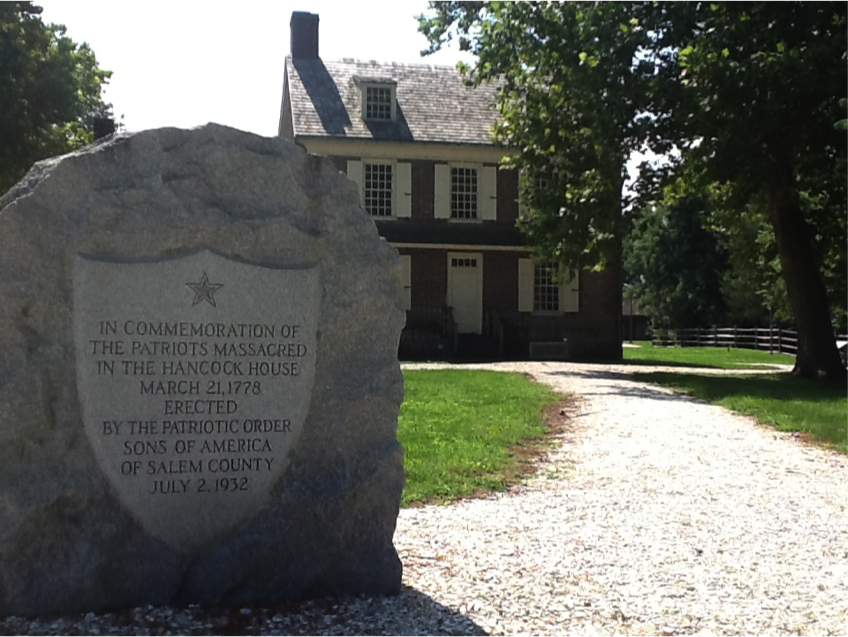
Footnotes:[1] Frank H. Stewart, Salem County in the Revolution (Salem: Salem County Historical Society, 1967) 45-47.[2] John G. Simcoe, John G. Simcoe’s Military Journal (Cranbury: The Scholar’s Bookshelf, 2005) 46.[3] Simcoe, Military Journal, 50-52.[4] Donald J. Gara, The Queen's American Rangers (Yardley: Westholme Publishing, 2015) 116-118.[5] Ibid., 141.[6] Stewart, Salem County in the Revolution, 63[7] Ibid., 61.[8] Simcoe, Military Journal, 53.[9] Stewart, Salem County in the Revolution, 65.[10] Ibid., 86.[11] Irene Y. Hancock, In the Shade of the Old Oak (Salem: Salem County Historical Society, 1964) 15.
 WILLIAM MICHELWilliam is a member of the 17th Regiment. He has volunteered and worked at several historic sites, including Valley Forge National Park, Graeme Park, Monmouth Battlefield State Park and is the current historian at the Hancock House State Historic Site in Salem County, NJ.
WILLIAM MICHELWilliam is a member of the 17th Regiment. He has volunteered and worked at several historic sites, including Valley Forge National Park, Graeme Park, Monmouth Battlefield State Park and is the current historian at the Hancock House State Historic Site in Salem County, NJ.
The Hancock House is located in Southern New Jersey. The historic site plans to host an event in Mid March of 2018 to commemorate the massacre. More information is coming soon.

